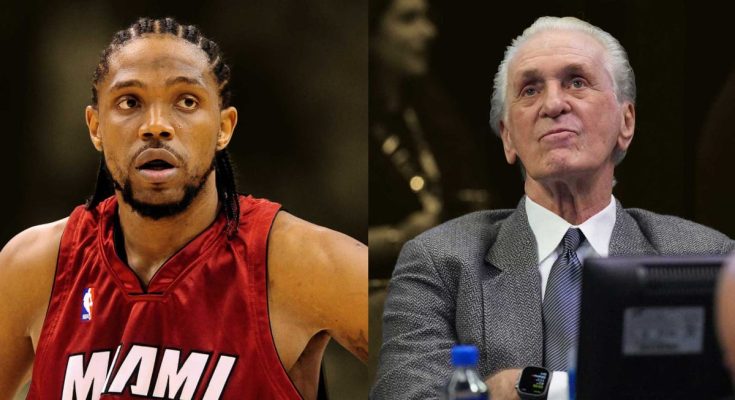When Udonis Haslem first entered the NBA, he was a young, hungry player eager to make his mark on one of the league’s most storied franchises, the Miami Heat. Fresh from the University of Florida, Haslem arrived in a city that demanded not only talent but toughness, resilience, and a certain mental fortitude. The Heat, led by their imposing president and head coach Pat Riley, had cultivated a reputation as one of the league’s most disciplined and exacting organizations, and Riley himself was the embodiment of that ethos. It didn’t take long for Haslem to realize that playing for the Heat wasn’t going to be easy, and that understanding hit him from the very first moments he stepped into the team’s world. “I was petrified of Riley… He’s a fu—ing monster!” Haslem would later admit, reflecting on his early years with the team, a candid acknowledgment that reveals the raw, human side of professional basketball’s often-intimidating culture.
At first glance, the dynamic between Haslem and Riley might seem like the classic coach-player relationship, one where discipline, accountability, and high expectations define the tone. But in Haslem’s case, it went beyond that. Riley was not just a coach who ran a tight ship—he was a figure whose very presence could command attention, demand respect, and at times, instill fear. The young Haslem, who was still finding his footing in the league, found himself grappling with the realization that he was no longer just a player; he was part of a system that demanded a level of mental and emotional toughness as much as physical skill. He had to navigate Riley’s towering presence, his intense scrutiny, and the unspoken pressure that came with wearing a Heat uniform.
It’s important to contextualize what made Riley such a formidable figure. By the time Haslem arrived, Riley had already cemented his status as one of the NBA’s most legendary coaches and executives. His tenure included multiple championship runs, iconic teams, and a persona that blended charisma with a commanding intensity. Riley’s approach was famously exacting, rooted in a philosophy that every detail mattered and that nothing was beyond critique. He had a reputation for being demanding, often pushing players to their limits not only on the court but off it, insisting on discipline, preparation, and an unwavering commitment to excellence. For a young player like Haslem, who had to earn his spot on a roster loaded with talent, encountering Riley’s intensity could feel like facing a force of nature.
Haslem’s candid admission about being petrified of Riley provides insight into the psychological dynamics at play. Many rookies enter the NBA with confidence in their physical abilities but without a full appreciation for the mental and emotional demands of the league. The Heat, under Riley, were notorious for testing a player’s resolve, and Haslem quickly realized that talent alone wasn’t enough. You had to earn your place, prove your worth, and withstand scrutiny that could feel overwhelming at times. The fear he experienced wasn’t just about being intimidated—it was a recognition that Riley demanded the best from everyone, and failure or complacency could come with consequences that went beyond the normal bounds of criticism in professional sports.
Yet, while Haslem’s early fear of Riley might be framed as intimidation, it also laid the groundwork for growth, resilience, and ultimately, a deep respect that would define their long-term relationship. Riley’s approach forced Haslem to confront his insecurities, to embrace accountability, and to develop the mental toughness that would become a hallmark of his career. It’s a dynamic that is often misunderstood by outsiders: the fear that young players feel under coaches like Riley is not about cruelty for its own sake—it is a crucible that forges character, shapes leadership, and establishes a culture of excellence. For Haslem, the initial terror of facing Riley evolved into a profound understanding of what it meant to be part of a franchise that demanded nothing less than commitment, focus, and resilience.
Reflecting on those early years, Haslem often recounts moments that capture both the intensity and the transformative power of Riley’s leadership. He remembers practices where every mistake was magnified, every lapse in concentration was called out, and every opportunity to excel was tested relentlessly. In those moments, fear was an inevitable response—it was a natural reaction to the high-stakes environment, where one’s future in the league could hinge on performance, attitude, and composure. But that fear was also instructive. It taught Haslem to sharpen his focus, to embrace discipline, and to internalize a professional ethos that would serve him not only on the court but in every aspect of his life as an athlete.
What makes Haslem’s story particularly compelling is the contrast between the initial fear and the enduring respect that developed over time. While he was petrified of Riley in the early days, that fear eventually gave way to admiration and gratitude. Haslem came to understand that Riley’s intensity was a reflection of his commitment to excellence, and that the challenges he faced were opportunities to grow. By the time Haslem became a veteran leader within the Heat organization, he had internalized the lessons imparted by Riley, becoming not just a skilled player but also a mentor, a voice of guidance, and a stabilizing presence for younger teammates navigating the same intimidating landscape he once did. In many ways, Haslem’s journey illustrates the broader truth about leadership and fear in professional sports: what initially terrifies can ultimately transform.
The relationship between Haslem and Riley also speaks to the culture of the Miami Heat as a franchise. The Heat have long been known for their toughness, their commitment to excellence, and their focus on mental and physical resilience. Riley’s leadership style embodies that culture, setting a standard that extends far beyond Xs and Os. Haslem, as a player who experienced the full weight of that standard, became both a product and a steward of the Heat’s ethos. His early fear was not an anomaly—it was part of the process by which the franchise instills discipline, accountability, and a relentless drive to succeed. Through that lens, Haslem’s admission is less about intimidation and more about the transformative power of high expectations.
Moreover, Haslem’s candid acknowledgment resonates with a broader audience because it humanizes the experience of professional athletes. Fans often see the glamour, the fame, and the success, but the psychological and emotional challenges of navigating elite sports are less visible. Fear, self-doubt, and the pressure to perform are realities that shape careers in ways that statistics and highlight reels cannot capture. Haslem’s reflection reminds us that even seasoned professionals start somewhere, often grappling with feelings of intimidation and uncertainty before growing into their roles. It also highlights the role of mentorship, leadership, and the sometimes tough love required to guide young talent.
Over the course of Haslem’s career, that initial fear of Riley translated into loyalty, longevity, and a deep connection to the franchise. Haslem became synonymous with the Heat, not just for his on-court contributions but also for his embodiment of the values Riley instilled: hard work, perseverance, and leadership. By the time Haslem became a veteran presence, he was mentoring rookies, setting standards, and helping to perpetuate the culture of accountability that had once petrified him. The cycle of fear, growth, and eventual leadership is a testament to the effectiveness of Riley’s approach, as well as Haslem’s capacity to rise to the challenge.
It is also worth noting that Haslem’s experience is emblematic of a broader trend in professional sports, where fear and respect often coexist as tools for development. Coaches like Riley leverage their intensity not to dominate for the sake of it, but to create environments where players must confront their limitations, push beyond them, and ultimately become more complete athletes and individuals. The psychological pressure, while challenging, serves a purpose: it cultivates resilience, encourages accountability, and fosters a sense of shared purpose. Haslem’s story underscores the delicate balance between intimidation and guidance, fear and growth—a balance that defines many of the league’s most successful franchises.
In retrospect, Haslem’s candid description of Riley as a “monster” is less a critique and more an acknowledgment of the profound impact Riley had on shaping his career. Fear, in this context, was a catalyst for transformation, a necessary discomfort that pushed Haslem to develop the mental fortitude, leadership skills, and competitive edge that would sustain him over nearly two decades in the NBA. It is a reminder that in elite sports, psychological toughness is just as critical as physical ability, and that the mentors who challenge us the most often leave the most enduring marks.
Today, Udonis Haslem is celebrated not just as a talented player, but as a symbol of dedication, loyalty, and resilience within the Miami Heat organization. His reflections on Pat Riley offer a rare glimpse behind the curtain, revealing the human emotions that underpin the world of professional basketball. Fear, respect, admiration, and gratitude all coexist in the narrative of Haslem’s early years, painting a vivid picture of what it means to grow under a demanding, exacting leader. The story is as much about personal development as it is about basketball—a testament to the ways in which challenge, intensity, and even fear can shape not only careers but character.
In the end, Haslem’s journey from a young player petrified of Riley to a seasoned veteran who embodies the Heat’s culture is a story of growth, perseverance, and transformation. It is a reminder that the figures who intimidate us at first often become the ones we respect the most, that fear can be a powerful teacher, and that the crucible of elite sports demands both mental and physical toughness. Udonis Haslem’s admission captures the essence of that journey, offering a candid, human perspective on what it truly means to play under a legend like Pat Riley—a legend whose presence is as commanding as it is transformative, a “monster” in the most formative sense of the word.



